Mostrar el registro sencillo del ítem
dc.contributor.author
Gomes, Marinna
dc.contributor.author
Alvarez, Maria Alejandra

dc.contributor.author
Quellis, Leonardo Ramos
dc.contributor.author
Laguía Becher, Melina

dc.contributor.author
Castro, Juciane Maria de Andrade
dc.contributor.author
Gameiro, Jacy
dc.contributor.author
Caporrino, Maria Cristina
dc.contributor.author
Silva, Ana Maria Moura da
dc.contributor.author
Santos, Marcelo de Oliveira
dc.date.available
2020-11-11T20:42:01Z
dc.date.issued
2019-03
dc.identifier.citation
Gomes, Marinna; Alvarez, Maria Alejandra; Quellis, Leonardo Ramos; Laguía Becher, Melina; Castro, Juciane Maria de Andrade; et al.; Expression of an scFv antibody fragment in Nicotiana benthamiana and in vitro assessment of its neutralizing potential against the snake venom metalloproteinase BaP1 from Bothrops asper; Pergamon-Elsevier Science Ltd; Toxicon; 160; 3-2019; 38-46
dc.identifier.issn
0041-0101
dc.identifier.uri
http://hdl.handle.net/11336/118222
dc.description.abstract
Human accidents with venomous snakes represent an overwhelming public health problem, mainly in rural populations of underdeveloped countries. Their high incidence and the severity of the accidents result in 81,000 to 138,000 deaths per year. The treatment is based on the administration of purified antibodies, produced by hyper immunization of animals to generate immunoglobulins (Igs), and then obtained by fractionating hyper immune plasma. The use of recombinant antibodies is an alternative to conventional treatment of snakebite envenoming, particularly the Fv fragment, named the single-chain variable fragment (scFv). We have produced recombinant single chain variable fragment scFv against the venom of the pit viper Bothrops asper at high levels expressed transiently and stably in transgenic plants and in vitro cultures that is reactive to BaP1 (a metalloproteinase from B. asper venom). The yield from stably transformed plants was significantly (p > 0.05) higher than the results in from transient expression. In addition, scFvBaP1 yields from systems derived from stable transformation were: transgenic callus 62 μg/g (±2); biomass from cell suspension cultures 83 μg/g (±0.2); culture medium from suspensions 71.75 mg/L (±6.18). The activity of scFvBaP1 was confirmed by binding and neutralization of the fibrin degradation induced by BnP1 toxins from B. neuwiedi and by Atroxlysin Ia from B. atrox venoms. In the present work, we demonstrated the potential use of plant cells to produce scFvBaP1 to be used in the future as a biotechnological alternative to horse immunization protocols to produce anti-venoms to be used in human therapy against snakebites.
dc.format
application/pdf
dc.language.iso
eng
dc.publisher
Pergamon-Elsevier Science Ltd

dc.rights
info:eu-repo/semantics/openAccess
dc.rights.uri
https://creativecommons.org/licenses/by-nc-nd/2.5/ar/
dc.subject
BAP1
dc.subject
BOTHROPS
dc.subject
HETEROLOGOUS EXPRESSION
dc.subject
IN VITRO PLANT CULTURES
dc.subject
MOLECULAR FARMING
dc.subject
SCFV
dc.subject.classification
Otras Ciencias Biológicas

dc.subject.classification
Ciencias Biológicas

dc.subject.classification
CIENCIAS NATURALES Y EXACTAS

dc.title
Expression of an scFv antibody fragment in Nicotiana benthamiana and in vitro assessment of its neutralizing potential against the snake venom metalloproteinase BaP1 from Bothrops asper
dc.type
info:eu-repo/semantics/article
dc.type
info:ar-repo/semantics/artículo
dc.type
info:eu-repo/semantics/publishedVersion
dc.date.updated
2020-11-11T12:39:50Z
dc.journal.volume
160
dc.journal.pagination
38-46
dc.journal.pais
Estados Unidos

dc.journal.ciudad
Cambridge
dc.description.fil
Fil: Gomes, Marinna. Universidade Federal de Juiz de Fora; Brasil
dc.description.fil
Fil: Alvarez, Maria Alejandra. Consejo Nacional de Investigaciones Científicas y Técnicas; Argentina. Universidad Maimónides; Argentina
dc.description.fil
Fil: Quellis, Leonardo Ramos. Universidade Federal de Juiz de Fora; Brasil
dc.description.fil
Fil: Laguía Becher, Melina. Consejo Nacional de Investigaciones Científicas y Técnicas; Argentina. Universidad Maimónides; Argentina
dc.description.fil
Fil: Castro, Juciane Maria de Andrade. Universidade Federal de Juiz de Fora; Brasil
dc.description.fil
Fil: Gameiro, Jacy. Universidade Federal de Juiz de Fora; Brasil
dc.description.fil
Fil: Caporrino, Maria Cristina. Governo do Estado de Sao Paulo. Secretaria da Saude. Instituto Butantan; Brasil
dc.description.fil
Fil: Silva, Ana Maria Moura da. Governo do Estado de Sao Paulo. Secretaria da Saude. Instituto Butantan; Brasil
dc.description.fil
Fil: Santos, Marcelo de Oliveira. Universidade Federal de Juiz de Fora; Brasil
dc.journal.title
Toxicon

dc.relation.alternativeid
info:eu-repo/semantics/altIdentifier/doi/http://dx.doi.org/10.1016/j.toxicon.2019.02.011
dc.relation.alternativeid
info:eu-repo/semantics/altIdentifier/url/https://www.sciencedirect.com/science/article/abs/pii/S0041010119300522
Archivos asociados
